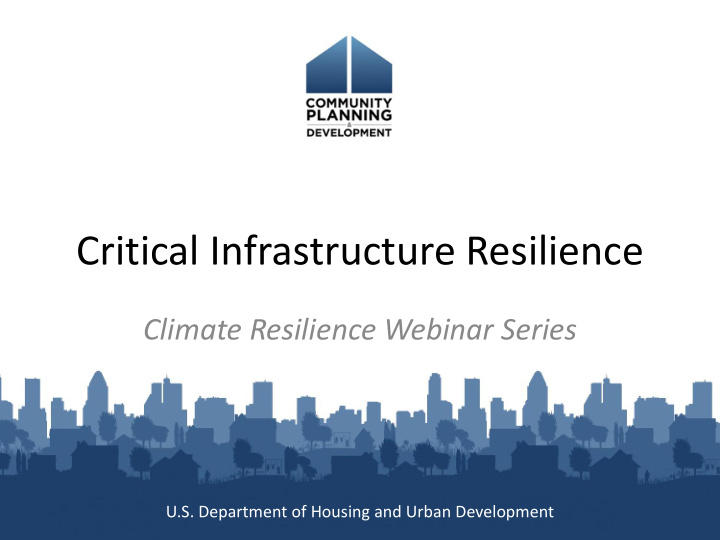



Critical Infrastructure Resilience Climate Resilience Webinar Series U.S. Department of Housing and Urban Development
Disclaimer • This presentation is intended to provide communities and states with the tools and information to help in climate resilience planning and activities. • Information presented in this webinar is independent of the Notice of Funding Availability (NOFA) for the National Disaster Resilience Competition (NDRC). While we expect that this information will be useful to interested communities and eligible applicants, it should not be construed as the definitive word on any singular approach to resilience . • All NOFA NDRC questions should be sent to: resilientrecovery@hud.gov 2
Presenter • U.S. Housing and Urban Development • Josh Sawislak, Senior Advisor to the Secretary for Infrastructure Resilience • Department of Homeland Security • Bob Kolasky, Director Strategy & Policy, Office of Infrastructure Protection 3
Agenda 1. Overview 2. Critical Infrastructure Resilience 3. Examples and Best practices 4. Questions 4
Critical Infrastructure Resilience Based on the President’s guidance in Presidential Policy Directive 21 ( Critical Infrastructure Security and Resilience ), critical infrastructure resilience is the ability to prepare for and adapt to changing conditions and withstand and recover rapidly from disruptions. 5
The Significance of Critical Infrastructure • Critical infrastructure refers to the assets, systems, and networks, whether physical or cyber, so vital to the Nation that their incapacitation or destruction would have a debilitating effect on national security, the economy, public health or safety, and our way of life. • 16 critical infrastructure sectors dispersed across the U.S. create a vast, interconnected ecosystem that sustains our way of life and the economic importance of the Nation. • These interdependent systems and networks rely on lifeline functions, including communications, energy, transportation, and water. Nuclear Comms. Emergency Reactors, Materials, Sector Services & Waste Critical Food & Government Manufacturing Agriculture Facilities Defense Energy Transportation Industrial Sector Base Systems Water & Wastewater Dams Health Chemical Sector & Public Sector Health Information Financial Commercial Technology Services Facilities 6
The Risks are Evolving Critical infrastructure in the United States faces current and future risks: • Terrorism • Extreme weather, natural hazards, and the risks of climate change • Cyber attacks • Pandemics • Accidents and/or technical failures 7
Involving a Diverse Set of Stakeholders The critical infrastructure community is comprised of a broad range of stakeholders, including: • Federal agencies, including those that lead coordination efforts for the 16 sectors (the Sector-Specific Agencies) • Private and public sector owners and operators of critical infrastructure • State, local, tribal, and territorial governments • Regional consortiums • Non-Governmental Organizations • Academia • Other Federal partners 8
Case for Investing in Resilience • It’s Good Business -- Disruptions can be costly, not only in the short term but also in the long term, so there is an incentive to prevent and minimize disruptions • Pay Now or Pay Later -- Some risks (e.g. risks associated with climate change) are expected to get worse, so it is prudent to think about resilience now while we have the chance to prevent disruptions • Save Money -- Investing in resilience may only require minimal up-front cost if resilience is considered when infrastructure is being designed • Incentives Exist -- There is an opportunity for the private sector to partner with the public sector to achieve mutual benefits • It’s About More Than Security -- Smart investments can serve dual purposes 9
Examples and Best Practices • Science-based Risk Analysis • Resilient Rebuilding • Interdependencies • Regional Coordination • Comprehensive Planning 10
Science-based Risk Analysis • Available Data • IPCC • National Climate Assessment • State and local downscaling • Tools/Data Sets • toolkit.climate.gov • climate.data.gov • rebuildbydesign.org 11
Resilient Rebuilding • Risk-based • Not just better, but smarter • Looking forward, not backward • Whole of community resilience 12
Interdependencies • Infrastructure is a System • Systems are Connected by Structural or Behavioral Relationships • Single Point Failures Can Lead to Cascading Impacts 13
Regional Coordination • Vulnerabilities Do Not Respect Political or Sector Boundaries • Work Across Jurisdictions and Sectors • Address Interdependencies • Create Leverage and Economies of Scale 14
Comprehensive Planning • “Make no little p lans…” • Building Code • Land Use • Reinventions • “Never let a good crisis go to waste.” 15
Taking Action on Resilience • How will you take leadership in resilience? • How will you work with partners (whether in the private sector or government) to design innovative ways to incorporate resilience? • How will you make forward-looking decisions given uncertainty? 16
Tools to Use: Infrastructure Resilience Guidelines Web References • Comprehensive Analysis • Hurricane Sandy Rebuilding • Transparent and Inclusive Strategy, pp 49-52 Decision-making Processes buildingstrategy.pdf • • Regional Resilience RAND Corporation review of application of the Infrastructure • Long-term Efficacy and Fiscal Resilience Guidelines for Sandy Sustainability recovery • Environmentally Sustainable • Rand's research_reports and Innovative Solutions • NIPP 2013 : Partnering for Critical Infrastructure Security and Resilience • Targeted Financial Incentives National infrastructure protection plan • Adherence to Resilience Performance Standards 17
What Can State, Local, Tribal, Territorial Entities Do Build Upon Innovate in Focus on Outcomes Partnership Efforts Managing Risk Attend training and promote risk Enhance relationships Provide feedback on the management activities; incorporate across infrastructure partnership model, risk risk management into the design of sector; Become familiar management framework, critical infrastructure; participate in with EO 13636 and PPD 21, and information sharing two-way information sharing and and PPD 8 practices provide input on best practices Participate in and encourage colleagues to attend training and Adopt the Cybersecurity Provide input on exercises, meetings, Framework potential incentives webinars, conference calls, cross sector events 18
Recommend
More recommend